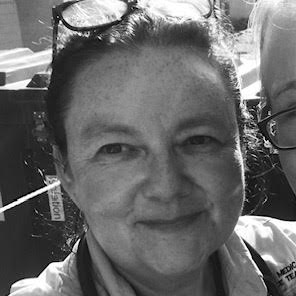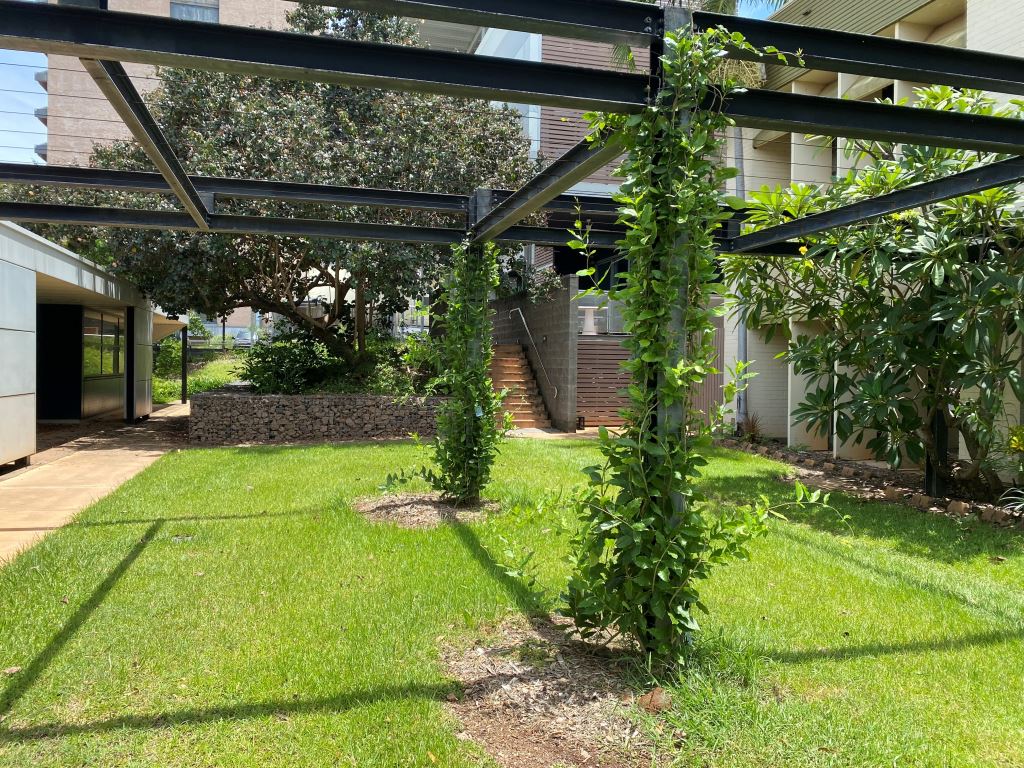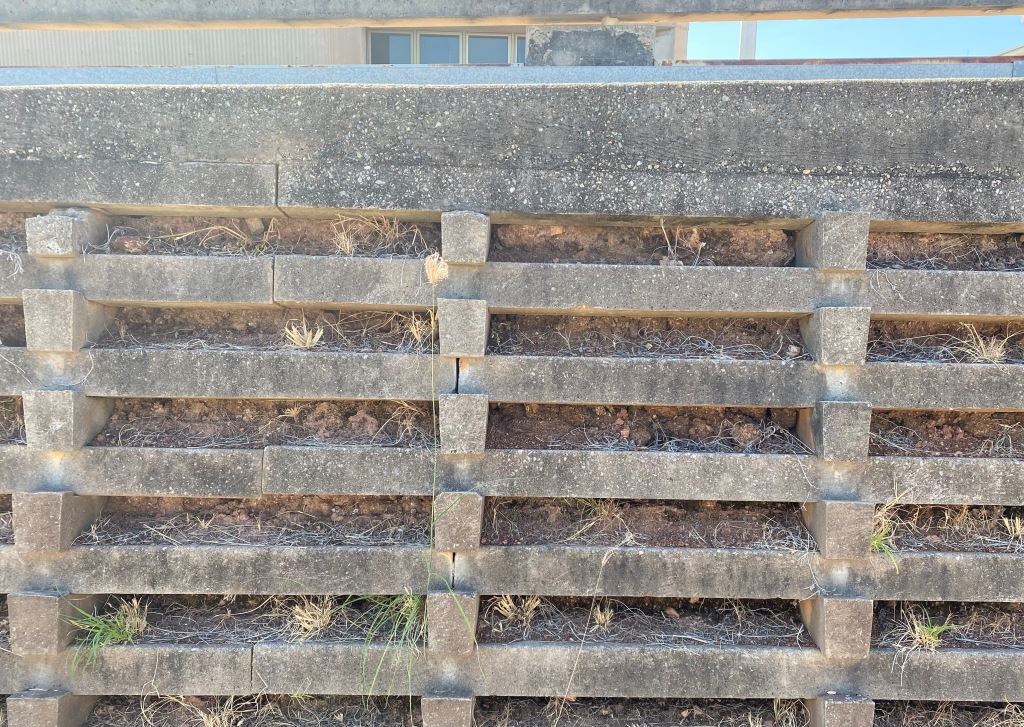Healthy patients, workforce, & environment: Hospital couples climate adaptation with health care wellbeing
Royal Darwin Hospital, Australia
Case study summary
This volunteer-led initiative activated the community, health workforce, and climate researchers to implement low-cost biophilic native landscaping within constraints of legacy infrastructure and funding scarcity. The project promotes staff and patient well-being, adaptation to a warming climate, support for the unfolding Australian biodiversity crisis, and enhances Indigenous cultural safety.
Demographic information
- City: Darwin
- State/province/region: Northern Territory
- Country: Australia
- Type of institution: Public hospital
- Number of full-time/casual staff: 2192/245
- Number of part-time staff: 788
- Patient population served per year
- Number of patients per year
- 71,497 inpatients (2022)
- 196,566 outpatients (2022)
- Number of patients per year
- Geographic area served:
- Part of Top End Health Service which covers 475,338 km²
- Top health equity concerns experienced by population:
- Delivery of culturally-safe healthcare for Indigenous Australians
- Effective communication across languages
- Aboriginal workforce and models of care
- Number of beds: 360
- Costs: AUD 19082.00


Now I deliberately park [my car] in Carpark 5 so I can take the longest route through the gardens
The issue
The Bureau of Meteorology predicts the average number of “extremely hot” days over 35°C in Darwin will triple by 2070.
The health workforce is under colliding operational pressures and is alarmed by the lack of action to tackle the health impacts of climate change.
Staff, patients, and visitors at Royal Darwin Hospital (RDH) had insufficient access to climate-adapted outdoor spaces.
Indigenous patients comprise 70% of RDH’s inpatients and prefer to sit outdoors. Hospital-based care is culturally challenging, involving separation from traditional lands and poor access to placed-based healing practices including bush medicines. These factors contribute to high Indigenous rates of patients leaving the hospital before treatment is complete.


Walking across the Royal Darwin Hospital campus from the carpark to the hospital entrance used to be like a SAS (Special Air Service) training exercise
Hospital goals
- Provide immediate psychological first aid to the workforce with local actions that reduce healthcare-related waste and emissions, cool the campus, and mitigate biodiversity losses.
- Promote workforce wellness using restorative biophilic spaces and encouraging active mobility
- Improve Indigenous health outcomes by enhancing cultural safety
Sustainability strategy implemented
The strategy aimed to combat health care worker exhaustion from operational pressures while mitigating the health impacts of climate change in the wet tropics. It incorporated strategic native plantings to reduce heat stress, promote active mobility, improve local biodiversity, promote cultural safety, sequester carbon dioxide, and reduce cooling costs. The project was endorsed by the health executive but not funded.
Baseline heat mapping was undertaken pro bono by the Commonwealth Scientific and Industrial Research Organisation (CSIRO).
Staff and community volunteers were recruited using multimodal communications. An active mobility campaign was created to promote wellness while reducing transport emissions.

Implementation process
Central to the design, was a collaboration with Aboriginal healers and plant experts to emphasize species of cultural significance, particularly those associated with traditional healing, ceremony, or favored as bush foods.
To promote climate literacy and project engagement, we hosted a heat mapping event, used social media platforms, email, and online forums, and promoted national coverage by two mainstream media outlets. We socialized the project at two national climate and health conferences. Northern Territory health executives were encouraged to promote awareness and support for the project within the health segment and on cross-sectoral finance, human resources, and infrastructure agendas.
Funding was provided by staff specialists, the Northern Territory Health Wellbeing Fund, Flinders Rural and Remote Health, and Rotary Sunrise Darwin. CSIRO, local arborists, landscape architects, surveyors staff, and community members donated plants, landscaping materials, professional services, and advice. The project was strongly supported by the hospital Operations Manager.
Volunteers from the community and multiple campus organizations (healthcare, education, research) attended 24 working bees (groups of volunteers doing charitable work) conducted over 18 months. A community of interest arose by posting social media tiles after events. This was amplified by volunteers’ posts which share sightings of plant growth, bloom, and native fauna.




Tracking progress
Ongoing readings of land surface temperature are consistently 22◦C lower at planting sites and may improve as canopies mature.
Sixteen native bird species have been sighted in the campus green spaces.
Hundreds of universally positive comments have been received on social media.
A research project is being planned that uses app-based technology to:
- Improve literacy and engagement on the biodiversity and climate crises.
- Capture data on green space use and perceptions of thermal comfort and well-being.
- Assess engagement in active mobility behaviors.
- Record biodiversity data.
- Seek specific feedback from Indigenous consumers.

I saw this section today in real life and it is so heartening!! Future staff and visitors will benefit so much from this!
Progress achieved
- The first Director of Sustainability Action has been recruited.
- More than 950 plantings of 139 local native Australian species are now established in 16 separate planting zones. Half of the 38 species of Indigenous cultural significance are now planted.
- The first active mobility campaign was conducted (ride to work event, Ebike raffle, bike storage landscaping, and repair station installed).
- A “Chalk the Campus” heat mapping event was conducted with users identifying hot spots and solutions.
- More than 250 volunteers were recruited to a social media group.
- Held an executive and ministerial campaign to prevent the removal of an established banyan tree resulting in an agreement on the importance of biophilic spaces in new health infrastructure.
- The infrastructure team collaborated to assist with the concept design of new walkways in key planting sites.
- Hospital operations teamwork plans amended to assist with maintenance.


Challenges and lessons learned
Funding remains an ever-present challenge to realizing the full scope of the project. It has also been difficult to maintain a steady supply of volunteers at organized events. Volunteer attendance is understandably diminished in hotter weather and the wet season when the burden of maintenance is greatest. The ability to maintain and expand the project as intended will best be supported by an employed workforce.
This initiative has provided a platform to elevate Indigenous knowledge and leadership in adapting to climate change and is enhancing the delivery of culturally safe care in our hospital.

Leading edge climate adaptation right here
Next steps
Enhance culturally significant plantings at the Indigenous accommodation precinct.
Install ethnobotanical signage and develop intranet resources to:
- Promote the well-being benefits of active mobility and using biophilic spaces
- Foster literacy on native plants including their Indigenous cultural uses.
Promote app-based engagement and data collection (biodiversity, cooling, well-being impacts).
Install seating and walking infrastructure.
Seek Indigenous consumer feedback and additional funding.
